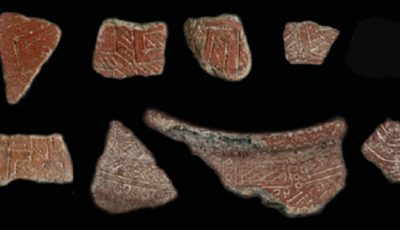‘Laulau settlement dates back to 1500 BC’

Dr. Mike Carson explains his findings during a presentation at the American Memorial Park on Dec. 7. (Michael T. Santos)
An excavation in Laulau Bay Saipan has shown that the earliest form of settlements in the Marianas dates back to 1500 B.C.
According to a recent archaeological research at Unai Bapot of Laulau led by Dr. Mike Carson, carbon dating tracked the origins of items found in Laulau to over the average date around the region.
In his presentation at the American Memorial Park Visitors Center Theater on Dec. 7, Carson said his team dug seven feet into the earth, the most they can do until hitting limestone. The items they found consisted of possible ornaments and pottery.
“One of the purposes of our excavation was to confirm, deny, or refine the radio carbon dating of the earliest layer. We have a number of sites in the Marianas that are about 1500 B.C. and some less than that. But with excavations we are finding things that prove to be much older,” Carson said.
By comparing language with others that are somewhat simila, DNA testing of other ancient people of different ethnic backgrounds, and archaeological items found, they also found that the most probable origins of the ancient Chamorro are from islands of Southeast Asia.
“Now that we know the date range of signs of the earliest settlements here on island, our next step is to find out more about them such as their housing and food they would eat. We are still working through some things but now that we have the right time frame, we can start narrowing down our searches based on the things were found,” Carson said.
During the excavation in Laulau, Carson made sure his team avoided all forms of human remains.
“We’re actually allowed to look at human remains but it’s not something I want to do at this time. I want to first learn as much from the ancient Chamorro through their archaeology. Once we have an idea of what to specifically look for, maybe we can start looking at the remains,” said Carson.
The newest findings are from an excavation done this past October in conjunction with the CNMI Historic Preservation Office.
Bones belonging to a species of bird was found at the site as well as plant residue preserved in several items, so more research will be done to find what the two are and if they are a whole new variety from what exists today.
One attendee of the event, Josh San Nicolas, said, “I really enjoyed the presentation. There were some things they found that I really didn’t know about and the questions at the end helped everyone have a better understanding of what the purpose is for digging into Laulau.”
The next round of information should be ready for the public some time next year in April.
Carson is a visiting associate professor of Archaeology at the University of Guam and a faculty of the Australian National University.
This presentation was sponsored by the Northern Marianas Humanities Council as a part of its ongoing Community Lecture Series.


























